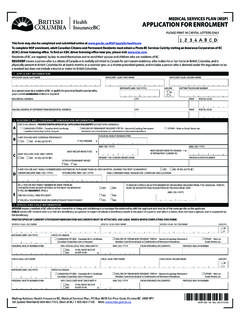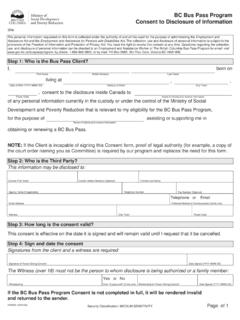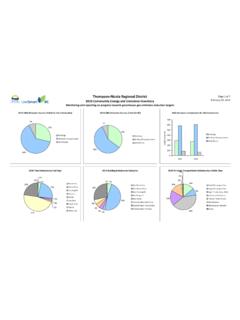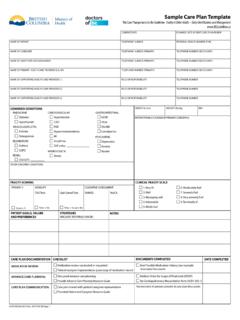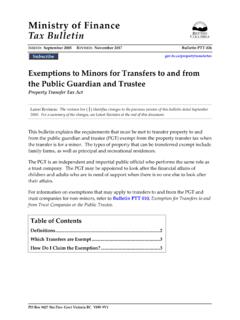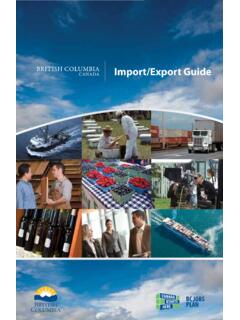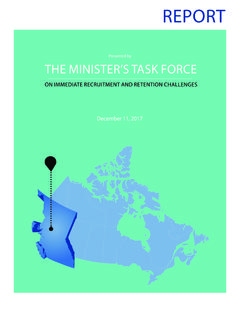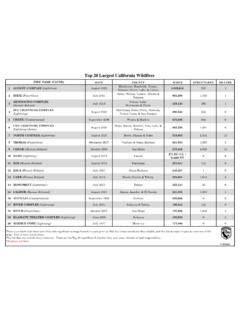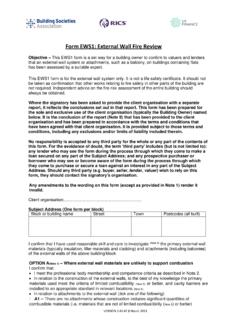Transcription of Structure Firefighters Competency and Training PLAYBOOK
1 British Columbia fire Service Minimum Training Standards Structure Firefighters Competency and Training PLAYBOOK Second Edition Amended: May 2015 Pursuant to paragraph 3(3)(b) of the fire Services Act of Page 2 of 20 Acknowledgements The Office of the fire Commissioner wishes to acknowledge the contributions of the following organizations in the compilation, consultation, evaluation and drafting of the fire Service Minimum Training Standards: fire Chiefs Association of British Columbia British Columbia fire Training Officers Association It was through the efforts of these organizations as well as staff and other individuals within the fire service that this PLAYBOOK was created. In moving forward, the PLAYBOOK is intended to be a living document that will be periodically reassessed with a view to enhancing or clarifying aspects identified by the fire service.
2 Table of Amendments Description Effective Date Original document issued September 2014 Amended May 2015 Page 3 of 20 Overview 1. Purpose: Under paragraph 3(3)(b) of the fire Services Act ( ), the fire Commissioner is required to establish the minimum standards of Training required for fire services personnel in British Columbia. This PLAYBOOK sets out a Competency -based ladder that provides for a minimum level of sequential Training and operational requirements that must be met by each fire department. The Authority Having Jurisdiction will set the Service Level (refer to pages 10, 17 and 18) to be provided by its fire department, which in turn determines the minimum Training Competencies that must be met by that department. The PLAYBOOK establishes the minimum Training Competencies required and the standards from which they are drawn.
3 2. Scope: This PLAYBOOK is applicable to all fire services personnel in British Columbia, as defined in the fire Services Act. It covers all fire departments and fire services, including municipal and regional district fire departments, fire brigades, volunteer fire departments, and fire departments established as a society under the Society Act ( ). This PLAYBOOK does not apply to provincial Wildfire Management Branch resources. For the purpose of this document, the term Authority Having Jurisdiction or AHJ describes the relevant local or regional government, or the entity (or persons) legally responsible for the organization and operation of the particular fire service. This PLAYBOOK is intended to provide an industry recognized minimum standard of Training that utilizes, and bridges to, the current National fire Protection Association (NFPA) Firefighter qualifications.
4 The Training requirements are expressly tied to the Service Level provided by a fire department, as formally determined by the Authority Having Jurisdiction. This document and program establishes the minimum Competencies necessary to perform the role of a firefighter, instructor/Evaluator and Team Leader at each designated Service Level, as well as for the delivery of in-house Training in such Competencies. The PLAYBOOK addresses the principal functional or operational roles for each Service Level but does not encompass all roles or functions of the fire service. The PLAYBOOK is not intended to change or nullify any requirements or Training related to other roles or functions in the fire service. This document and program does not cover the minimum standards for the skills and Training necessary to perform other advanced or specific functions/roles such as, but not limited to: Incident Commander, Driver/Operator, Incident Safety Officer, or Rapid Intervention Team.
5 The Training for such roles and functions must meet the requirements of the Workers Compensation Act ( ) and any other applicable statutory or regulatory requirements. These additional Training requirements need to be considered by the AHJ when determining the Service Level to be provided by its fire service. Page 4 of 20 3. Principles: It is the responsibility of each AHJ to select and declare its firefighting Service Level, which in turn determines the Training Competencies that must be met by the fire service for which it is responsible. The PLAYBOOK standard outlines the minimum competencies which are drawn from the NFPA standards. The declared Service Level must be established as formal policy for the Department (whether by bylaw, policy or in contract) and needs to be fully reflected in the fire department s operating guidelines and policies.
6 The AHJ s decision as to the appropriate Service Level for its fire service should be based upon: local conditions; consultation with representatives of local fire service delivery organization; availability of resources and the ability of those resources to respond; the realities of the community in terms of demographics, risks, travel distances, fire hall locations, equipment and staffing models; and the ability of the AHJ to financially support its fire department to enable it to meet all applicable Training , safety and operational requirements for the chosen Service Level. This PLAYBOOK establishes three Service Level options from which an AHJ may choose. Once a Service Level is established, each AHJ must ensure that its fire service meets the appropriate Competency requirements as identified in the Competency ladder, as well as for the functions and roles not expressly covered by this PLAYBOOK .
7 Ensuring compliance with minimum standard established in this PLAYBOOK is the responsibility of the AHJ. As a Competency -based program, formal certification (whether Accredited Certification or other third-party Certification), while encouraged, is not required by this PLAYBOOK . Each firefighter must be provided Training and evaluation in all applicable Competencies, including theoretical classroom and hands-on practical skills, which are required by the chosen Service Level. Assessments and evaluations of Competencies can be carried out internally by the AHJ so long as the evaluation instruments follow the criteria of this PLAYBOOK (and other applicable NFPA Standards) and that detailed records of firefighter Training and evaluation are maintained.
8 4. Competencies The PLAYBOOK establishes and describes the minimum Competencies required of firefighter roles in the following three categories: Exterior Operations Level Firefighter; Interior Operations Level Firefighter; and Full-Service Operations Level Firefighter. Page 5 of 20 In addition, the PLAYBOOK establishes three new supervisory responsibilities with related Training Competencies or responsibilities. These are: Exterior Operations Level Team Leader; Exterior Operations Level Risk Management Officer; and Interior Operations Level Team Leader The fire service has a number of well-established officer ranks within its Structure . However, use of departmental officer rank identification is not included within this PLAYBOOK as such ranks do not necessarily signify an operational role on the fire ground.
9 The supervisory roles and responsibilities identified above do not require new positions in the department; they simply reflect specific skills and Training required to lead a functional crew or to ensure a department is meeting its administrative requirements. Each department must determine the number of these trained individuals required based on the Service Level it provides and its operational requirements. A department may choose, through its operational guidelines or policies, to associate the functional skills and Training requirements for these supervisory positions to specific fire officer and incident command roles. 5. New Terminology: Team Leader: In this PLAYBOOK , the term Team Leader is applied to identify the individual, whether a firefighter or officer, responsible for a specific crew function at an emergency incident.
10 Background: On the fire ground most departments operate in a manner whereby not all activities are supervised by an officer; commonly there are simply not enough officers for all the functions being performed. Usually a functional role being performed, such as ventilation, results in the identification and assignment of a Team Leader. This individual may commonly be referred to as the Ventilation Team Leader, or some other functional description. Frequently a senior or more qualified firefighter will lead the team, even if they are not of officer rank. This reality is identified and accounted for in this PLAYBOOK . This terminology also recognizes the reality of elected officers in some department structures who may not have advanced operational qualifications or skills necessary for providing supervision at an emergency scene.
